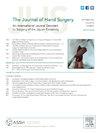近端指间关节扭伤后的肿胀、僵硬和功能障碍。
IF 2.1
2区 医学
Q2 ORTHOPEDICS
引用次数: 0
摘要
目的:近端指间关节(PIP)扭伤是一种常见的损伤,通常会导致长时间的肿胀、僵硬和功能障碍;然而,这些后遗症的持续时间尚不清楚。本研究的目的是确定 PIP 关节扭伤后患者手指肿胀、僵硬和功能障碍的持续时间:这是一项前瞻性纵向调查研究。为了识别 PIP 关节扭伤患者,我们每月使用《国际疾病分类》第十版中 PIP 关节扭伤的代码查询电子病历。每月通过电子邮件发送一份包含五个问题的调查问卷,为期一年,或直到他们的回复显示肿胀缓解为止,以时间在前者为准。我们建立了两个队列:自述在 PIP 关节扭伤后 1 年内受累手指肿胀缓解的患者(缓解队列)和未缓解的患者(未缓解队列)。测量结果包括自我报告的肿胀消退情况、自我报告的活动范围限制、日常生活活动限制、视觉模拟量表(VAS)疼痛评分以及恢复正常情况:在93名患者中,有59人(63%)在PIP关节扭伤后1年内完全消除了肿胀。在肿胀消退的患者中,42%的人报告主观上已恢复正常,47%的人自述活动范围受限,41%的人自述日常生活活动受限。肿胀缓解时,VAS 疼痛评分的平均值为 0.8(满分 10 分)。相比之下,在肿胀未消退组中,只有 15% 的患者报告主观感觉恢复正常,其中 82% 的患者自述活动范围受限,65% 的患者自述日常生活活动受限。该组患者 1 年后的平均 VAS 疼痛评分为 2.6(满分 10 分):结论:PIP 关节扭伤后,患者普遍会经历长时间的肿胀、僵硬和功能障碍:预后IV级本文章由计算机程序翻译,如有差异,请以英文原文为准。
Swelling, Stiffness, and Dysfunction Following Proximal Interphalangeal Joint Sprains
Purpose
Proximal interphalangeal (PIP) joint sprains are common injuries that often result in prolonged swelling, stiffness, and dysfunction; however, the duration of these sequelae is unknown. The purpose of this study was to determine the duration of time that patients experience finger swelling, stiffness, and dysfunction following a PIP joint sprain.
Methods
This was a prospective, longitudinal, survey-based study. To identify patients with PIP joint sprains, the electronic medical record was queried monthly using International Classification of Disease, Tenth Revision, codes for PIP joint sprain. A five-question survey was emailed monthly for 1 year or until their response indicated resolution of swelling, whichever occurred sooner. Two cohorts were established: patients with (resolution cohort) and patients without (no-resolution cohort) self-reported resolution of swelling of the involved finger within 1 year of a PIP joint sprain injury. The measured outcomes included self-reported resolution of swelling, self-reported limitations to range of motion, limitations to activities of daily living, Visual Analog Scale (VAS) pain score, and return to normalcy.
Results
Of 93 patients, 59 (63%) had complete resolution of swelling within 1 year of a PIP joint sprain. Of the patients in the resolution cohort, 42% reported return to subjective normalcy, with 47% having self-reported limitations in range of motion and 41% having limitations in activities of daily living. At the time of resolution of swelling, the average VAS pain score was 0.8 out of 10. In contrast, only 15% of patients in the no-resolution cohort reported return to subjective normalcy, with 82% having self-reported limitations in range of motion and 65% having limitations in activities of daily living. For this cohort, the average VAS pain score at 1 year was 2.6 out of 10.
Conclusions
It is common for patients to experience a prolonged duration of swelling, stiffness, and dysfunction following PIP joint sprains.
Type of study/level of evidence
Prognostic IV.
求助全文
通过发布文献求助,成功后即可免费获取论文全文。
去求助
来源期刊
CiteScore
3.20
自引率
10.50%
发文量
402
审稿时长
12 weeks
期刊介绍:
The Journal of Hand Surgery publishes original, peer-reviewed articles related to the pathophysiology, diagnosis, and treatment of diseases and conditions of the upper extremity; these include both clinical and basic science studies, along with case reports. Special features include Review Articles (including Current Concepts and The Hand Surgery Landscape), Reviews of Books and Media, and Letters to the Editor.

 求助内容:
求助内容: 应助结果提醒方式:
应助结果提醒方式:


